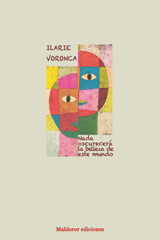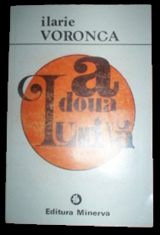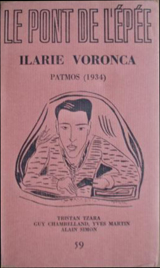BIBLIOGRAFÍA
POÈMES
Ulysse dans la cité. 1933. Éditions du Sagittaire, traduit du roumain par Roger Vailland avec une préface par G. Ribemont-Dessaignes et un dessin par Marc Chagall.
Poèmes parmi les hommes. 1934. Éditions des Cahiers du Journal des Poètes avec un portrait par Edmond Vandercammen.
Patmos. 1934. Éditions des Cahiers Libres.
Permis de Séjour. 1935. Éditions Corréa.
La poésie commune. 1936. Éditions G.L.M.
La joie est pour l'homme. 1936. Éditions Les Cahiers du Sud.
Pater Noster. 1937. Éditions Avant-poste.
Amitié des choses. 1937. Éditions Sagesse.
Oisiveté. 1938. Éditions Sagesse.
L'apprenti fantôme. 1938. Éditions des Presses du Hibou.
Le marchand de Quatre Saisons. 1938. Éditions des Cahiers du Journal des Poètes.
Beauté de ce monde. 1939. Éditions du Sagittaire.
Les Témoins. 1942. Éditions du Méridien, 1942.
Contre-solitude. 1946. Éditions Bordas.
Les chants du Mort. 1947. Traduit du roumain avec la collaboration de Jacques Lassaigne, Éditions Charlot.
Diner, chez Jeanne Coppel. 1952. Collages originaux de Jeanne Coppel, Éditions PAS.
Poèmes inédits. 1964. Avec un dessin d'Abidine. Éditions Guy Chambelland.
PROSES
Lord Duveen ou l'invisible à la portée de tous. 1941. Éditions de l'Ilot.
La confession d'une âme fausse. 1942. Éditions du Méridien.
La clé des réalités. 1944. Éditions du Méridien.
L'interview. 1944, avec un portrait par Halicka. Éditions Jean Vigneau.
Henrika. 1945. Avec un frontispice de F. Delanglade.
Souvenirs de la planète Terre. 1945. Éditions Nagel.
Onze récits. 1968. Éditions Rougerie.
Perméables. 2005. Éditions Le trident Neuf.
REFERINTE CRITICE
E. Lovinescu, Istoria, III; Perpessicius, Mentiuni, I-V;
P. Constantinescu, Scrieri, V;
G. Calinescu, Principii; idem, Istoria;
I. Pop, in Tribuna, Nr. 18, 1965; idem, in Tribuna nr. 23, 1966;
E. Ionescu, in Tribuna, nr. 14, 1968;
N. Manolescu, Metamorfozele;
I. Pop, Avangardismul; S. Pana, in Luceafarul, nr. 11, 1971;
C. Veronca, in Romania literara, nr. 32, 1971;
D. Pillat, Mozaic istorico-literar, 1971;
Al. Piru, in Romania literara, nr. 39, 1972;
C. Cio-praga, in Cronica, nr. 52, 1973;
Dana Dumitriu, in Romania literara, nr. 42, 1973;
Al. Philippide, in Luceafarul, nr. 6, 1973;
M. Zaciu, in Tribuna, nr. 10, 1973; idem, in Manuscriptum, nr. 3, 1973; idem, Ordinea si aventura, 1973;
Ovid S. Crohmalniceanu, Literatura, II;
N. Balota, Arte poetice ale secolului XX, 1976;
I. Negoitescu, Analize si sinteze, 1976;
I. Vartic, Spectacol interior, 1977;
H. Zalis, in Saptamana, nr. 335, 1977;
Gh. Grigurcu, in Steaua, nr. 4, 1978;
C. Sorescu, in Saptamana, nr. 413, 1978;
S. Cioculescu, in Flacara, nr. 6, 1979;
B. Brezianu, in Secolul 20, nr. 11-12, 1980;
M. Bucur, Poezie-destin-drama, 1982;
M. Mincu, Avangarda literara romaneasca, 1983;
D. Micu, Modernismul romanesc, I-II, 1984-1985;
M. Scarlat, Istoria poeziei romanesti, III, 1986;
I. Pop, in Revista de istorie si teorie literara, nr. 3-4, 1987; idem. Avangarda in literatura romana, 1990;
Gh. Grigurcu, De la Mihai Eminescu; 1989; idem, A scrie si a fi. Ilarie Voronca si metamorfozele poeziei, 1993;
D. Micu, Scurta istorie a literaturii romane, II, 1995;
M. Papahagi, Interpretari pe teme date, 1995.
NERUDA TRADUCTOR: EL EJEMPLO RUMANO
44 Poetas rumanos representa un caso particular entre las traducciones de Neruda, no tanto porque Neruda no leyera el rumano, cuanto por el hecho de ser su traducción más extensa (136 poemas). Del francés, Neruda había traducido "La voz de Henri Martin" de Nazim Hikmet, "La ciudad durmiente" y "El incendio terrestre" de Marcel Schwob, el "Año 1812" de Adam Mickiewicz y un fragmento de Los cuadernos de Malte Laurids Brigge de Rainer Maria Rilke. Hernán Loyola ha reunido estas obras en Nerudiana dispersa II, un título sugerente para el lugar incierto que las traducciones ocupan en el estudio de la literatura.
Las notas de Loyola muestran que la genealogía de un poema traducido se traza a menudo con datos inconclusos. Junto a las versiones literales o literarias confirmadas o en vía de esclarecerse, lo que rodea el texto cobra importancia. Con la "La voz de Henri Martin" estamos frente a una traducción indirecta del turco, pero al mismo tiempo el poema evidencia la amistad entre Neruda y Hikmet. György Somlyó y Semión Kirsánov, traductores de Neruda al húngaro y al ruso durante los años de militancia comunista de Neruda, o los rumanos Eugen Jebeleanu, Maria Banuş, Veronica Porumbacu y Mihai Beniuc, cuyos nombres aparecen en las páginas de Confieso que he vivido, en cartas y en 44 Poetas, constituyen ejemplos similares.
A diferencia de las demás traducciones, 44 Poetas solicitó una colaboración abarcadora. El libro fue impreso en diciembre de 1967, el mismo año en que Losada sacaba la primera edición de La barcarola. Sin embargo, Neruda firmó las "Palabras del traductor" desde Isla Negra casi dos años antes (enero de 1965). Porumbacu le había enviado las versiones en francés (más de 6.000 versos) con una carta fechada 14 de julio de 1960. Ennio Moltedo, quien tomó parte en la revisión final del trabajo en La Sebastiana, sostiene que Neruda tardó más de un año en completar el libro. Pese a lo fragmentario de estos datos, la historia de 44 Poetas nos lleva a un cruce de asociaciones donde se perfilan simultáneamente dos zonas de la traducción: una privada, en la cual Neruda, a través del texto, entra en una conversación con la poesía de Tudor Arghezi, Lucian Blaga, Ilarie Voronca y Benjamin Fundoianu entre otros; y una zona pública que pone en marcha un engranaje de entidades que le dará presencia al texto.
Debido a su publicación durante los años del regimen socialista, esperaríamos tal vez que 44 Poetas fuera un libro uniforme respecto a la elección de obras. Pero su aparición coincide con un período de cambio anunciado ya por la retirada de las tropas soviéticas en 1958. En su aprobación, Nikita Kruschev parece no haber anticipado que una medida pensada en términos militares llevaría a tensiones irreversibles entre Bucarest y Moscú; y que en el transcurso de pocos años, la nueva élite del Partido Comunista Rumano adopataría un plan económico y cultural reorientado hacia los países del occidente, empezando con Francia, como era de esperar.
La apertura significó retomar el hilo de la herencia latina común y alejarse de las fuentes eslavas. En esta postura que buscaba su modelo en el occidente hay resonancias claras del argumento que los intelectuales ilustrados de Transilvania habían defendido a fines del siglo dieciocho. El proyecto de los pensadores de Şcoala ardeleană estuvo también ligado a objetivos políticos y sociales. En la correspondencia que Neruda recibe de su amiga Veronica Porumbacu encontramos breves ilustraciones de los cambios culturales. En su carta de julio 1960, por ejemplo, Porumbacu cuenta con entusiasmo que pese a estar en plena temporada muerta de verano, en la vida artística de Bucarest se habían dado encuentro al lado del TeatroVahtangov de Moscú, Il Piccolo Teatro de Milán con una obra de Goldoni y el Teatro del Vieux-Colombier.
Las nuevas ediciones Eminescu, Arghezi y más tarde Blaga, o Barbu representan la recuperación de un pasado literario, sin que el retorno dejara de tener en cuenta las premisas de una cultura dirigida. Una periodización de la poesía rumana traducida por la pareja Rafael Alberti-María Teresa León, Neruda, Hubert Juin, Luc-André Marcel, Alain Bosquet y Salvatore Cuasimodo —es decir, poetas que han alcanzado valor canónico en la literatura europea— indica que las decisiones locales concordaban con las internacionales.
44 Poetas no es un libro unitario. Como si se tratara de la prolongación de una ruptura nunca definitiva y nunca resuelta en su propio Canto general, Neruda propone a través del prólogo una interpretación de los poemas que entra en conflicto con otras lecturas sugeridas por los poemas mismos. "Palabras del traductor" no es una crónica donde Neruda expone sus estrategias de traductor, sino lo que Genette denominó un prólogo umbral, es decir "una zona no sólo de transición sino también de transacción (subrayado suyo)" que orienta al lector.
Son páginas introductorias con una finalidad didáctica. La imagen de Drácula o Vlad Ţepeş con la que se abre el prólogo pertenece a una metáfora más amplia que trata de desmontar un mito construido históricamente en sentidos divergentes en la narrativa occidental y en la historiografía rumana. Pronto entendemos que los recursos del lenguaje están destinados a producir un cambio de óptica. Los términos de la métafora cambian y con ello el espacio entendido como geografía se convierte en espacio histórico. Las tinieblas de los Cárpatos donde por siglos se albergó "aquél vampiro siempre vestido de frac" con "alas metamorfósicas y membranosas" dejan de ser la naturaleza poetizada en el folklore medieval europeo para transformarse en símbolo de un pasado histórico conceptualizado en torno a la idea de confrontación.
Siguiendo las pautas de la estética del realismo socialista se construye la dicotomía entre un ayer injusto, pobre y obscuro por un lado y un hoy justo, moderno y luminoso por otro lado. Esta modernidad que se origina en el pensamiento político envuelve como una espiral otra modernidad, una modernidad estética que muchos de los poetas traducidos buscaron más allá de las distincciones políticas vigentes en los años de entreguerra. [...]
Gabriela Căprăroiu
University of California, Los Angeles
— escritural
TOM SANDQVIST. DADA EAST: THE ROMANIANS OF CABARET VOLTAIRE.MIT PRESS, 2006.
Tom Sandqvist’s book, Dada East: the Romanians of Cabaret Voltaire, is an example of the growing Western interest in the Central and Eastern European avant-garde. This interest has at least two precedents worthy of notice: Steven Mansbach’s book, Modern Art in Eastern Europe: From the Baltic to the Balkans ca. 1890-1939 and an important exhibition organized by Los Angeles County Museum of Art, Central European Avant-gardes: 1910-1930, which was accompanied by a substantial catalogue. Tom Sandqvist’s book aims to achieve a reexamination of Dada Zurich by looking closely at the geopolitical, historical and cultural context from which some of its protagonists emerged. Dada East may be regarded as another contribution employing the recently established perspective and methodology to provide an alternative to the traditional historical accounts of modernism and the avant-garde.
In order to foreground some new hypotheses for the creation of new genres of poetry and performance, Sandqvist makes considerable efforts to demonstrate that the Romanian peasant culture, as well as the Jewish (particularly the Yiddish and Hassidism cultures), infused the intellectual and spiritual background of Tristan Tzara, the Janco brothers and Arthur Segal. These sources became of primary importance for the artistic innovations that took place in Zurich. Although these sources are not to be overlooked, they should nevertheless be more cautiously considered, as the extensive documentation on the doctrine of Hassidism, for example, does not necessarily demonstrate its relevance in the context of the Dada activities, nor does it prove Tzara’s or Janco’s attachment to it.
In the next paragraphs I will focus on the question of Jewishness and Hassidism discussed in the book in the chapters “In Yiddishland” and “Ex Oriente Dada.” After a long excursus that introduces the reader to the history of Hassidism and its development within the Slavic countries and Romania, Sandqvist goes on to conclude, based on mere cultural contiguity, that the “ecstatic dances and songs” associated with the Hassidic rituals had a profound impact on the thinking of both Tzara and Janco: “Undoubtedly, one of the sources of inspiration must have been the surrounding Hassidism when Tzara already around 1914 tried to liberate the words from their lexical meaning at the same time as he tried to create “abstract” poems of pure sounds without mimetic reference to the reality."
We are also told that Hassidism was at the origin of the modern notion of the désoeuvrement, a notion closely related to the idea of the nullified subject in Tzara’s poetry. The extended discussion around the influence of Hassidism includes the example of Arthur Segal, another Romanian of Jewish origin, who was associated with the movement in Zurich and took part in exhibitions organized by the Dadaists, who published his woodcuts in the Dada magazines Cabaret Voltaire, Dada 3, and Der Zeltung. Segal applied the concept of “artistic equivalence” in his abstract paintings, which was derived from the ethical principle of equality and non-hierarchical organization. Sandqvist is tempted to believe that the Hassidic conviction according to which “all people are equal before God and before themselves in an ultimate, immovable harmony” was translated by Segal into his artistic theory, a theory that nonetheless had an explicit political spin.
However, these assumptions are weakened further on in the text when the author admits that “neither the Rosenstock family nor the Janco family confessed Jewish Orthodoxy and Hassidism,” at which point Sandqvist brings forward the argument that Tzara and his well-off family (who had sent him to a French private school in Bucharest) experienced a process of assimilation. According to Sandqvist, this process resulted in a “hide-and-seek” game that Tzara would continue to play with regard to his Jewish identity, as Tzara sought to dissociate himself from his Jewish background but at the same time, preserved some distinctive traits pertaining to the Jewish culture and tradition, which were deeply embedded in his personality.
Sandqvist is unconvincing when, on the one hand, he suggests that Tzara, as an assimilated Jew, wanted to break with the tradition and forge a new identity for himself. But on the other hand, Sandqvist makes a case for a rather unproblematic assimilation of some of the elements which are part of the Jewish culture and tradition and that seem to have suddenly gained an unexpected pertinence for the understanding of the Dada activities. The reader is left with the impression that a richly documented account of the cultural context in which both Tzara and Janco grew up leads automatically to a fresh reading and reevaluation not only of these artists’ activities, but of Dadaism in general. In order to stress the importance of Tzara’s Jewishness, Sandqvist turns to a more general discussion; that of the connection between Jewish culture and the “new modernist aesthetics.” However, Sandqvist offers no consistent or plausible explanation for this linkage and limits himself to briefly mentioning such personalities as Marc Chagall, El Lissitzky and Franz Kafka.
Indeed, the discussion around the possible links between Jewish culture and the avant-garde practice is an important topic of the Romanian historiography of modern art and needs to be addressed further. Many scholars have noticed the great number of personalities of Jewish origin associated with the avant-garde movement in Romania; apart from Tzara, Janco and Segal, who are mostly regarded as members of the international avant-garde (Janco being an exception, as he became extremely active in his native country after returning to Bucharest in 1922), other important personalities within the Romanian context include M.H. Maxy, Victor Brauner, Sasa Pana, Ilarie Voronca, F. Brunea-Fox, and B. Fundoianu (Benjamin Fondane). Romanian scholar Andrei Cornea dismisses the idea that there are inherent qualities which might be indicative of a certain Jewish specificity and believes that in Tzara’s case, his Dadaism cannot be put in any kind of relation to his Jewish origin. On the other hand, Stephen Mansbach believes that “these ‘pseudo-Romanians’ as they would later be designated, advocated a culture whose very experimental and cosmopolitan cast would affirm their outsider status while simultaneously making Bucharest an international capital of modernism.”
Mansbach argues that after World War I, when Romania gained new territories and the minority population increased significantly, “the foreignness that had long characterized Romanian culture would take on a new dimension during the 1920s when the avant-garde reached its maturity." In line with such an assessment, Sandqvist suggests that Tzara’s revolt against the constraints imposed by social conventions may be partly linked to his Jewishness and to the fact that the Jewish population in Romania, and particularly in Moldavia, was subject to racial intolerance, both through anti-Semitic legislation and through a widespread popular resentment against those of Jewish origin.Sandqvist argues that witnessing such unfair treatment of this ethnic minority in his home country might have fueled an attitude of revolt against systemic orders in Tzara, which would be perfectly consistent with the anarchist impulses that existed at Cabaret Voltaire. However, in relation to Jewish identity, Sandqvist’s approach seems to be too simplistic, as he fails to provide an adequate analysis of the identity tensions brought about by the process of assimilation, not to mention the fact that the very issue of Jewish specificity is a delicate subject that cannot be tackled without in-depth consideration.[...]
Magda Radu (Bucharest, Romania)
Thursday, 18 October 2007
— Art Margins
— Nord Literar

































